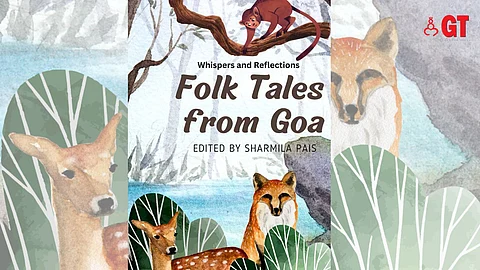

Those of us that grew up before the digital age have memories of hearing tales told to us by our grandparents or some elderly person from the family or village.
Some of the old folk had a particular knack for storytelling and would have us in rapt attention. These stories served the purposes of entertainment, passing down the legacy of folklore and often imparting to the youngsters a bit of wisdom.
Now those tales of old come to us in the form of a book Folk Tales from Goa, edited by Sharmila Pais and published by Goa,1556. Sharmila has been an associate professor of history at St Xavier’s College, Mapusa, for more than two decades.
In 2018, she received her doctorate on the theme of elections in colonial Goa, leading to her publishing her maiden work, The Encounter with the Ballot in Colonial Goa.
Coming from a generation that played traditional outdoor games and indulged in the pastime of listening to folktales, Sharmila says, “I had the privilege of listening to captivating tales from the seasoned storytellers of my family, my father Epitácio Pais and uncle Sidónio Pais. In these narratives, animals took centre stage, engaging in conversations with humans and expressing emotions that brought the stories to life.”
“Sharing these stories with my children when they were toddlers and students kept the legacy of these tales alive in memory,” explains Sharmila.
Though compiling Goa’s folklore is something she had wanted to do for a while, time was an issue. A more feasible solution to her time constraints was calling for contributions from individual writers.
This task was taken on by Frederick Noronha of Goa,1556, who requested folktales people knew of on an online platform. The response was fantastic.
Sharmila says, “This collection has unveiled a treasure trove of narratives, some familiar and others that lay hidden in memory. A few storytellers of Goa have used the familiar spoken word – Konkani – to carry the wisdom of the ages. The reader will experience the flavour of Goan customs, traditions, dietary habits, music and institutions within this collection of folk stories and a few essays.”
It was in January 2024 that Sharmila spoke to Frederick Noronha of her idea for a compilation of Goan folktales. Frederick, who always backs literary endeavours, especially anything to do with Goa, was intrigued by the concept. He suggested a theme and encouraged Sharmila to explore the idea further.
The book was to have a Konkani title when the process of collating began, something that translated as “Grandma’s Bites”.
Sharmila persuaded her students to unearth tales and even spoke to colleagues and friends to aid her in the project.
Frederick shared the idea with fellow writers on a WhatsApp group who were enthused by it. A flyer was circulated on several social media platforms to raise awareness of this project.
Sharmila persuaded her students to unearth tales and even spoke to colleagues and friends to aid her in the project. “I am proud to announce the successful compilation of 60 folktales from Goans based in different corners of the world,” says Sharmila.
It was a challenging process in terms of time management, editing and corresponding with contributors. Sharmila also had to balance work, personal responsibilities, travel and the project.
She says, “I was happy to correspond with many professional writers whose submissions were presented lucidly. But certain vernacular words needed translations to ensure accuracy and enrich the narrative.”
Through her research on folklore, Sharmila learnt that stories could be allegorical, ritualistic or simply entertaining.
Through her research on folklore, Sharmila learnt that stories could be allegorical, ritualistic or simply entertaining.
She says, “Allegories employ symbolic characters to convey norms, philosophical concepts and taboos of society at a given point in historical time. Animals in folktales often represent exemplary symbols with specific traits. For instance, a wise owl exemplifies wisdom.”
“We learn wisdom from the metaphorical lessons of these stories. The actions and behaviour of animals can serve as metaphors for human behaviour. Animals may be seen as messengers, protectors or guides from the spirit world,” she continues.
The folktales in the book represent Goan culture and heritage. They delve into historical events or convey moral lessons of Goan society. Many Goan folktales revolve around animals, the kolo (jackal) in particular. Different versions of the same story have emerged due to oral and repeated storytelling.
With the knowledge that young people will listen to folktales with complete fascination, especially if the storyteller possesses the flair of relating them effectively, Sharmila says, “I am optimistic that this compilation will interest readers and educate them on the rich heritage of Goa.”
Folk Tales from Goa will be launched on November 9, 2024, at 4.45 pm at Broadway, 18th Jn Rd, Panjim. Call +91 9822122436 to RSVP.
DETAILS
WHAT: Book launch of Folk Tales from Goa
WHERE: Broadway, 18th Jn Rd, Panjim
WHEN: November 9, 2024, at 4.45 pm
RSVP: +91 9822122436